Hoop-jumping and council consents: Michael Andrew’s journey of building a home from scratch
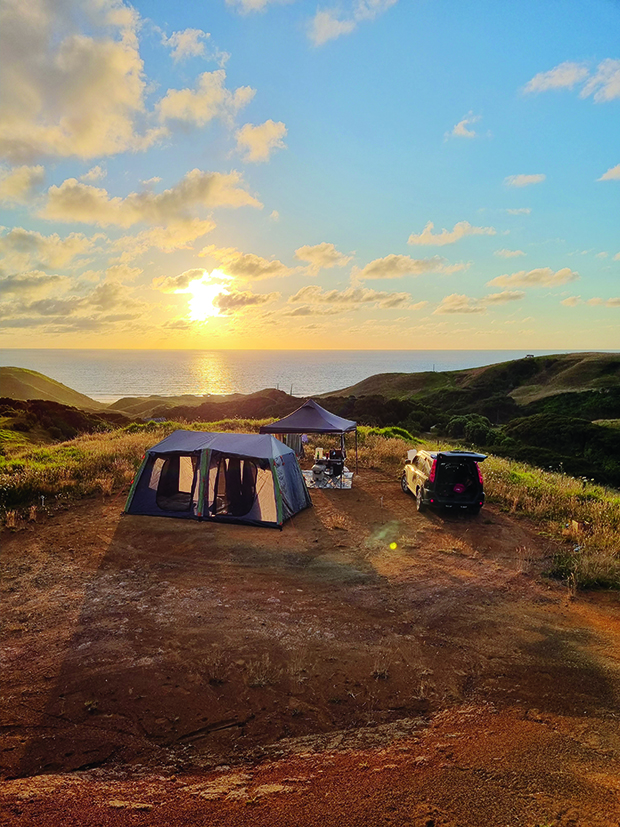
My block and the site of the future house – currently a private camp ground.
In the first of a series of stories chronicling his new house build, NZ Lifestyle Block editor Michael Andrew writes about the essential yet tedious hoop-jumping business of council consents.
Who: Michael Andrew
Where: Waikato
What: Bareblock, campground, future house site
Land: 2.5 acres
High on a lush, sun-baked bush block overlooking Waiheke Island’s Onetangi beach, is a tiny 1960s bach owned by my grandmother. Virtually unchanged since it was built, apart from the addition of some french doors and new joinery to replace the rotted windows, the small building is a true icon, a humble shack clinging to the hillside like a hardy mountain goat. Walk east along the beach and you’re bound to see it – a simple grey square poking out of the bush, the last of its kind, dwarfed by the mansions and manors dominating the ridge.
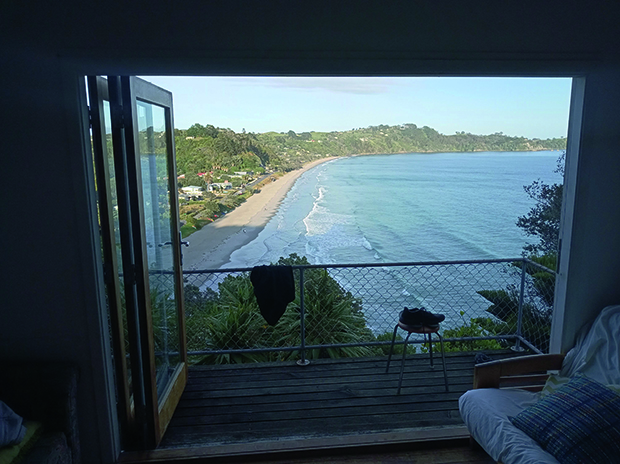
Other than its epic views and ramshackle aesthetic, what I like best about the bach is the story of its origins. Like most dwellings in those days, the process to build it was simple. A man showed up, bought the land, and with nothing more than some hand tools, his bare hands and a basic permit, assembled a robust and sound structure that stood the test of time. There was little paperwork or bureaucratic palaver – the authorities trusted the builder’s workmanship, grounded in the square and level tenets of carpentry – which delivered a dwelling that has been a sanctuary for hundreds of people over the past 60 years.
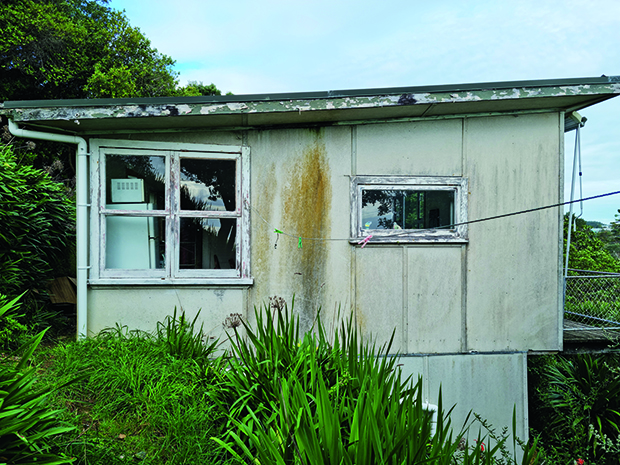
The tiny 30m² bach is shared among a vast family – the progeny of my grandmother – and is considered an almost sacred place, prized for its views and simplicity.
The reason I love stories about these simple old dwellings is because they contrast so drastically with the building process today. Anyone who has built a house in the past 20 years will be no stranger to the administrative complexity that is bound to surround the project. Whether it’s long wait times for applications, high fees, inspection hold-ups or vague requests for legislative information, the whole process is sticky with convolution – demanding more time, more money and more uncertainty for the property owners.
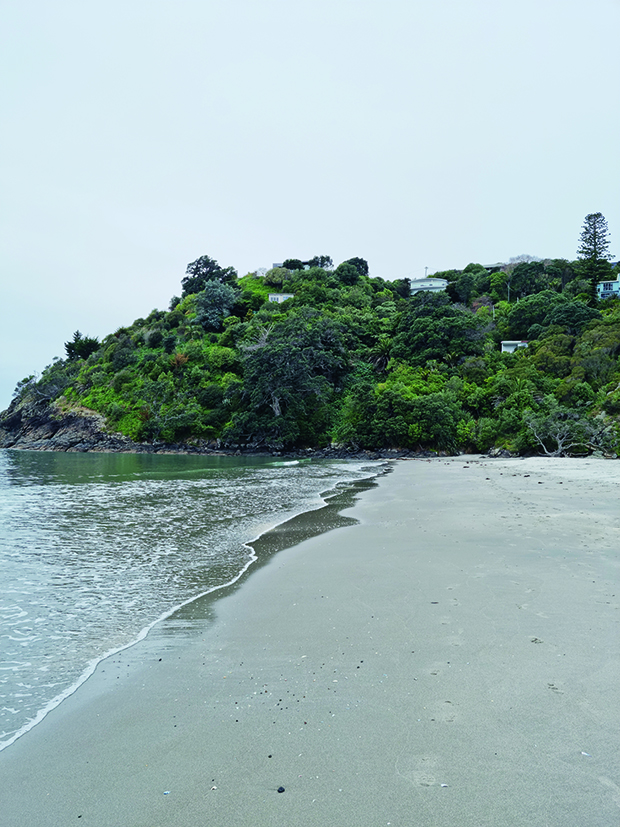
The bach sits in the upper middle of the picture, dwarfed by the mansion to the right
Although I become wistful about the simplicity of building 60 years ago, I did not expect to find such ease during my own house build on my land in the Waikato. I went into it expecting tedium, and tedium is what I got. This allowed me to be resilient in the face of delay and complexity, and pleasantly surprised whenever something happened quickly. I also told myself that despite the bureaucratic flaws of both the building and resource consent process, they represent legitimate intentions to ensure safe housing and to protect the environment. It made the burden easier to bear.
And so in 2022, with open minds and a laughable budget, my wife and I waded into a world we’d been advised to fear. In truth, house building was uncharted waters, and neither of us knew how to pilot or navigate the boat. But there was a strong current, and we felt compelled to draw up the anchor and follow it along.
But before we did anything, we needed to know what we were building.
THE REPORTS
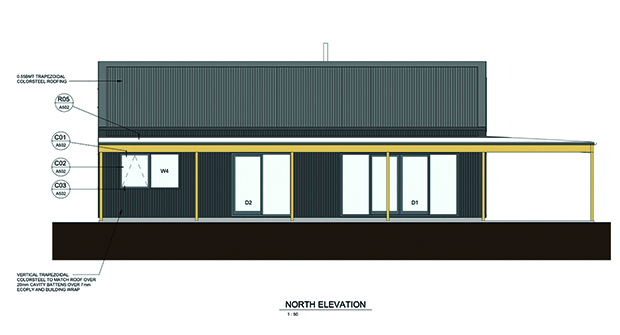
The concept of the house, showing the black Colorsteel exterior. Colour and light reflectance values were important considerations for the council, and we had to show we weren’t using any garish hues such as pink. The colour needed to complement the surrounding landscape.
The first step involved drawing up our house plans. While we had the option to design the house from scratch and engage a draughtsperson to draw the floor plan, we instead went through a company called Greenbridge Healthy Homes and selected one of their plans for a small, affordable 78m2 house. Greenbridge – a family owned business based in New Plymouth – was very easy to deal with, providing us with tailored advice and guidance, and an opportunity to redesign the plans to fit our preferences and budget, and our builder’s recommendations.
The next step involved commissioning a couple of reports to fulfil the conditions of the resource consent on the property – already granted before we took ownership. The consent essentially stipulated that whoever bought the property – former farmland that had been subdivided into a one-hectare block– needed to provide a landscaping/vegetation plan showing that the house build would be screened from the roadside, and a geotechnical report showing that the land on which we would build was suitable and stable.
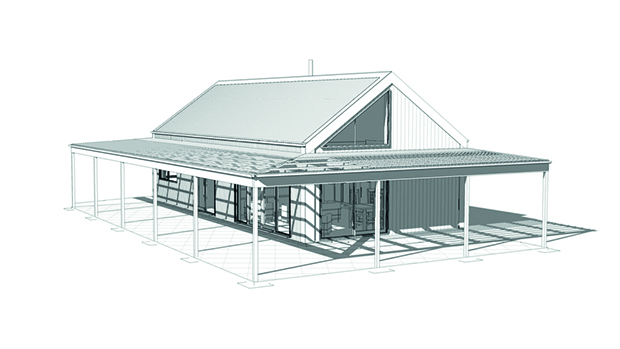
We engaged a local landscape architect and a geotech engineer to produce the reports, which they did fairly promptly for a combined cost of around $7,000. The landscape architect was surprised that any report was needed, as the building site was already screened from the roadside by the topography. Rather than wasting time in futile argument with the council, we went into our savings and jumped through the hoops.
Once the reports were completed, we sent them to Greenbridge and gave them authority to engage the Waikato District Council on our behalf. They lodged the consent application, we paid the application fee of around $2,500, and waited.
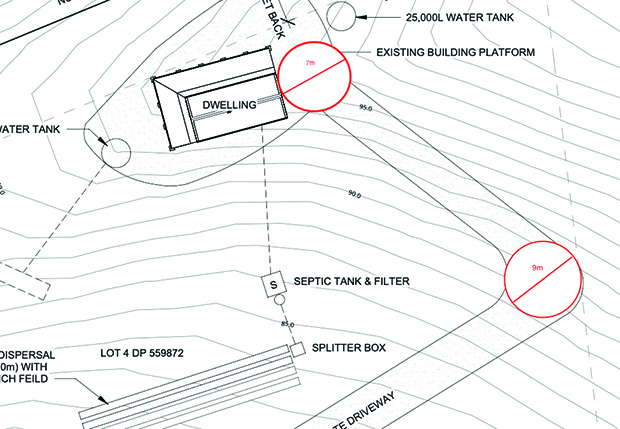
The site plan including turning circles to show that the proposal met the district plan’s transportation rules.
THE RESOURCE CONSENT
In a typical example of the kind of naivety that has pestered this project, we didn’t know until after the council got back to us approving the building consent that we needed to apply for resource consent as well. The consent for the subdivision had already been sorted by the previous owner, but it turns out we needed a separate application for land use. Most people will warn you not to purchase land that requires resource consent, but we’d already come this far, so we took a deep breath and forged ahead.
Greenbridge offered to produce and submit the resource consent application on our behalf, but to keep costs down I opted to do it myself. I had no idea where to start. Apart from the general instructions on the Ministry for the Environment website, all I had to go off was an email from the Waikato District Council with some vague, indecipherable information about why the resource consent was needed:
Waikato District Council has notified its decisions on submissions on the Proposed District Plan on 17 January 2022. From this date forward any development or subdivision will need to be assessed under both the Operative District Plan (ODP) and the decisions version of the Proposed District Plan (PDP).
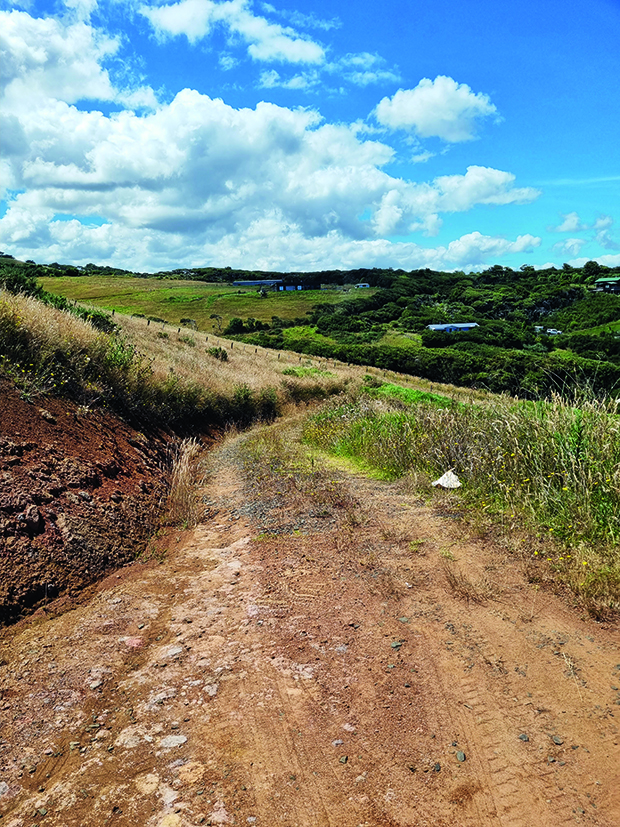
The driveway that needs to be upgraded.
Any non-compliance in either of the Plans will require a Resource Consent (i.e. if a proposal is compliant with all the rules under one plan and is non-compliant with any rule in another plan, then Resource Consent is still required). It does not need to be non-compliant with both plans to require a Resource Consent.
Although I work with words for my livelihood, the above instructions were complete nonsense to me. I had no idea why I needed resource consent, or what I needed to do to get it.
Convoluted communication is a widespread trait of bureaucratic entities. In most cases, 200 words are used to describe something that only needs 20 words, and often the messengers don’t actually know what information is required.
They send you links to district plans and pieces of legislation, but even when you find the documents and the rules referred to, seldom are they relevant to your project. No one tells you what to write in your application, nor is there a guide. The best way to do it, I found, is to ask someone who’s done it before.
I managed to track down a neighbour who had built a minor dwelling a few years back, and he was kind enough to send me his RC application. He had one big piece of advice: “don’t be a smart ass”. If I submitted a complex application with too much information, diagrams and evidence, he said, it would take the council far longer to review it. They’d likely hit me up on a great many points before ultimately rejecting the entire thing as punishment for my arrogance.
But if I provided the most basic information, they would possibly take pity on me as a naive simpleton and hold my hand as they told me exactly what to include in a resubmission.
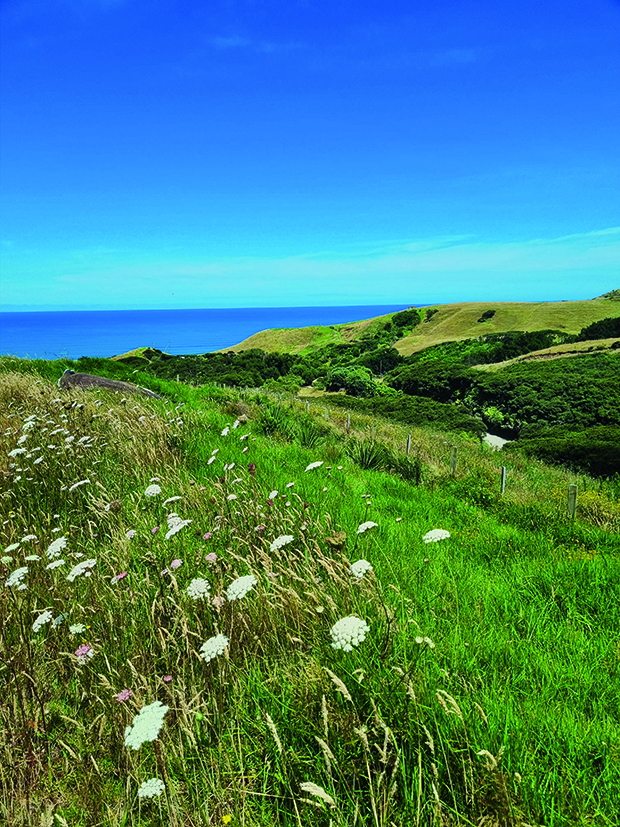
The surrounding area is classed as sensitive rural land with significant natural features. We needed to show our project wouldn’t impact these values.
That advice turned out to be pure gold.
I wrote the application as simply as possible: “I want to build a house for my family, it will be small and black, it won’t disturb the neighbours, it won’t destroy the rivers and oceans. I will plant lots of trees.”
I submitted it, paid another fee of $2,000, and waited.
True to my neighbour’s advice, the council responded by gently rejecting my application, but were kind enough to tell me the sections of the district plan I needed to assess against my proposal. It still wasn’t clear what was being asked of me, but at least it was a step in the right direction.
And so I began the long process of reading through the vast and arcane “rules” of two district plans and their schedules, and writing out why my house build would be compliant with each one. As I worked, I began to comprehend why the resource consent was needed. It turns out that the property is located in an area with significant ecological and rural character. The council wanted to make sure I wouldn’t compromise these features by building a giant eccentric monstrosity that dominated the landscape, or by scarring the land with excessive earthworks.
That was perfectly understandable.
But what weren’t understandable were the rules and sub-rules I kept coming across within the documentation. For example, one rule read: “Illumination from glare and artificial light spill shall not exceed 10 lux measured horizontally and vertically at the notional boundary on any other site in the Rural Zone.”
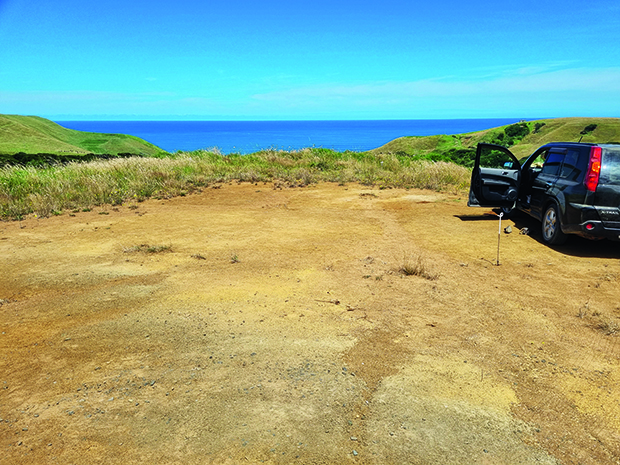
Although exceedingly specific, these rules had a tenuous connection to my proposal and I grew increasingly horrified at the thought that I might have to engage electrical engineers and the like to prove that the light from my house wouldn’t “exceed 10 lux”, whatever that means. This would result in many thousands of dollars and months, if not years, of delay.
Fortunately, the council planner assigned to me had provided her mobile number in case I had any questions. I called her and shared my concerns, and to my relief, she instructed me to disregard most information in the district plans, and to focus only on three parts. The hardest aspect of working with these documents is navigating through the immense volume of content, and finding what you want. The planner was kind enough to share the links to the exact pages, and provide the precise reference numbers for the rules I needed to adhere to.
From there, it was a relatively easy process of using technical evidence to prove that the proposed activity would be compliant with each rule. For example, one rule says a house must not exceed a certain height, so all I needed to do was reference the house plans showing the house height, attach a screenshot of the drawing, and state that the house was compliant with this rule.
The only part that required a bit of work was the traffic rules, which specified that the vehicle access needed to have a turning circle of a particular size. This involved finding the council’s diagrams and specifications online, and the measuring out on google maps that the proposed turning circle was within their required dimension.
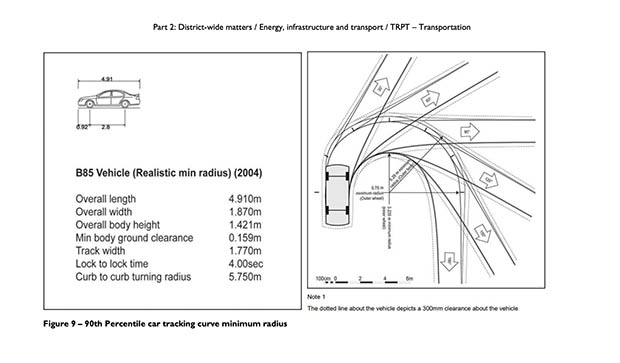
The council diagrams specifying turning circle dimensions.
Much of it was repetition. Many rules required the exact same response, and the exact same references, but it was a fairly common sense process. After a week of solid work, the draft application was finished.
I edited it, made it look fancy and professional and sent it off to the planner.
After less than two weeks of waiting, I got a response: my resource consent had been approved and I could start the build. It took less than three months in total. Despite the costly consent conditions, such as upgrading the driveway and installing erosion controls, knowing I had successfully pulled off a complex piece of DIY administration was an immensely satisfying moment.
A few days later, I got another email from the council reminding me to pay the balance of what I owed them. Attached were a couple of invoices adding up to $6,000.
“Ah well,” I thought.
“It’s only money.”
QUICK TIPS FOR CONSENT APPLICATIONS
• Put aside the money: It’s hard to tell how much the council and report fees will be. Keep around $10,000 to cover off anything unexpected. If it’s less than that you can put the balance into the build.
• Talk to people: Find people in your area who have filed consent applications before and ask to see their documents.
• Be patient: While most councils will respond within 20 working days, different authorities have different time frames. The process may also be delayed if your application is rejected or requires further information.
• Don’t be dismayed by the mess: Despite the complexity of council documentation, there is method in the madness. You just need to find out where to look.
• Most importantly, be kind and polite to the council: The people processing your application are working within the system, they don’t make the rules. Treat them with respect and they’re likely to help you out, potentially processing your application faster.
Love this story? Subscribe now!
 This article first appeared in NZ Lifestyle Block Magazine.
This article first appeared in NZ Lifestyle Block Magazine.
